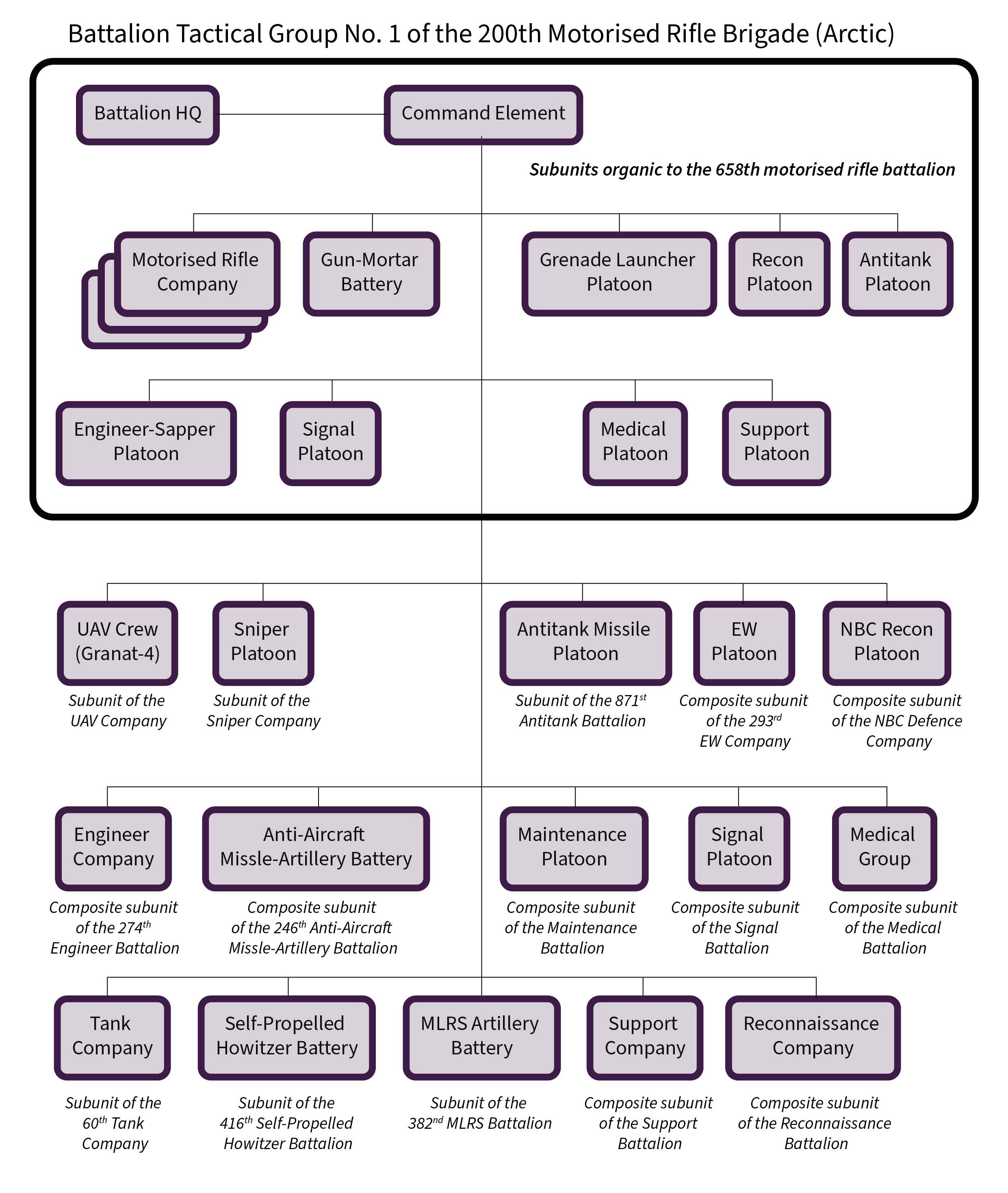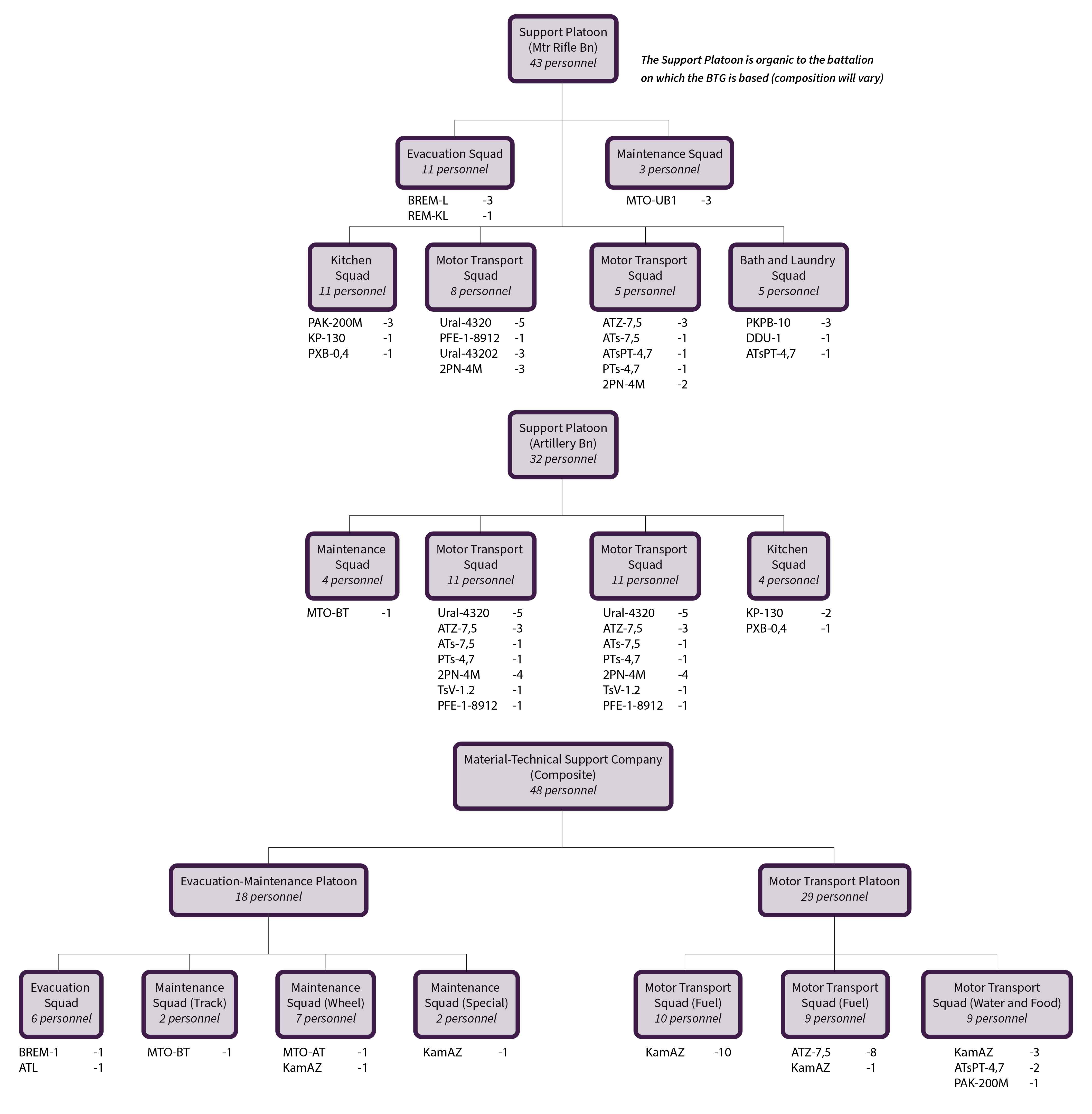Getting to Know the Russian Battalion Tactical Group
Much has been written on Russia’s battalion tactical groups in recent weeks. It is thus of value to revisit their origins and capabilities, and the roles they were set up to play.
Introduction
Success in modern conventional warfare is determined by a combination of effort, environment and – to an extent – luck. However, the most important determinants of victory are the actions of combined arms units. Only these units, in cooperation with other branches of arms and other military services, can perform the full spectrum of defensive and offensive tasks. The execution of these tasks depends upon the enemy’s composition, position and probable course of action; the position and condition of one’s own subordinate, attached and supporting units; the conditions of the area on which the assigned tasks will occur; and weather. Traditionally, Russia’s lowest echelons capable of performing combined arms tasks were the regiment or brigade, but experimentation in the 1980s led to a semi-permanent combined arms formation at the battalion level, the Battalion Tactical Group (BTG).
Russia’s 2022 invasion of Ukraine has made the term ‘Battalion Tactical Group’ commonplace beyond the expert community, from the mass media to YouTube and a plethora of blog sites. Though understanding of the invasion is still in its infancy, this article intends to shed some light on what a BTG is, and how it is used in a Russian military context.
At the time of writing, details are still sketchy, but based upon media reports and a few captured Russian maps, it appears that Russia has conducted a partial mobilisation, deploying only partial divisions/regiments, brigades, and independent BTGs. Larger formations have apparently deployed only with their BTGs, leaving their other manoeuvre battalions in garrisons. Although the Russians appear to be having difficulties, this structural change was likely envisioned from the beginning of the operation, as the scale of the conflict is unsuitable for the sole use of independent BTGs. The BTG was ideal for earlier fighting in support of separatist ethnic Russian elements in Donetsk and Luhansk; however, large-scale combat requires large-scale combined arms operations and battalions fighting as part of larger entities.
The brigade/regiment may now be the primary unit of manoeuvre, but some independent BTGs likely remain in play. They are either being spun off a parent regiment/brigade for a particular mission (such as forward detachments, advance guards, raiding detachments, flank guards, or urban assault detachments) or may be entirely independent. It is likely that some BTGs will be subordinated to regiments/brigades that they are not otherwise affiliated with, and possibly to different branches, including the naval infantry and airborne troops (VDV), if expedient.
History of the Battalion Tactical Group
The BTG is not a new feature in Russian military thought. The Russian Civil War (1917–1923) included raiding groups, forward detachments, rear guards, advance guards and other mobile battalions comprised of horse cavalry, machinegun detachments mounted on horse-drawn carts, horse-drawn artillery, and occasional tanks or armoured cars. Their focus was on speed, manoeuvre, the ability to mass fires and forces, and the interaction of these forces to achieve a combined combat power greater than the component parts. During the Second World War, the Soviets fought primarily with separate infantry, armour and artillery units that occasionally fought as combined arms units, but usually integrated shortly before the battle. Artillery and artillerymen were always present in infantry battalions in the form of mortars, direct-fire cannon and antitank rifles.
During the Cold War, the Soviets realised that combined arms units were more effective than integrating branch units just before the fight. There were problems integrating them in garrison and training. Branch units occupied their own barracks. Tanks, personnel carriers and artillery required different maintenance parts and services. Branch weapons qualification required different ranges and facilities. Branch proficiency was necessary before putting different branch soldiers together in exercises or combat. So the Soviet Army trained for branch skills, but when it went on field exercises, it fought combined. The results were not always inspiring. Commanders struggled to integrate their branch forces with those of other branches – though units that trained together on a sustained basis performed better.
Over time, divisions and regiments became fairly proficient in combined arms combat, but the nature of the battlefield was changing. Modern weapons forced units to spread out in order to survive. The future battlefield would be fragmented, with gaps between units, open flanks and combat not only at the front line, but also throughout the battlespace. The concept of the front line itself was being challenged. It thus became obvious that the battalion was a prime component of future war and battalions had to fight combined to win. The problem was how to combine branches into battalions and fight effectively. What was the optimum mix of tanks, mounted infantry, artillery, engineers, air defence and other branches? How could they be trained simultaneously and effectively in branch and combined arms skills?
Throughout the Cold War, the Soviets tried different combinations of forces in an effort to create an optimum Combined Arms Battalion, or Battalion Tactical Group in the Russian parlance. It had to be lethal, yet not too large, capable of acting independently for a period of days, and able to fight combined effectively. From the 1960s to the end of the 1980s, the Soviet Motorised Rifle Battalion and Tank Battalion went through several Table of Organisation and Equipment (TO&E) changes to try to improve their combined arms lethality. During the same period, they conducted hundreds of exercises using different mixes of tanks, motorised rifle, air defence, engineers and combat support forces, looking for the optimum solution. Clearly, the Soviets were trying to determine the optimum TO&E structure, training and employment of BTGs.
After the collapse of the USSR, the impetus to develop the BTG was strengthened by Russia’s experience during the Chechen campaigns and related counterterrorism activities. During this period, the 58th Combined Arms Army manoeuvre regiments formed BTGs based on motorised rifle battalions that were reinforced with tanks; artillery; air defence; reconnaissance; engineering; chemical, biological, radiological and nuclear defence; communications; maintenance; and logistics units. These BTGs were 100% equipped and manned, with mostly contract personnel, and were on a six-month readiness cycle until their personnel were rotated out. Many characteristics of today’s BTG can be directly traced to this time.
Battalion Tactical Groups in Today’s Russia
Today, the BTG is a semi-permanent task force found in the manoeuvre (motorised rifle and tank) regiments and brigades of the Russian Ground Forces, Naval Infantry and VDV. BTGs are task-organised motorised rifle or tank battalion-plus-sized combat entities that can perform semi-independent combined arms combat missions. They are capable of conducting deep raids, envelopments and flanking manoeuvres. In the Russian system, the lowest echelon of combined arms command has traditionally been the manoeuvre regiment or brigade. Thus, the Russians do not use terms like ‘Regimental Tactical Group’ when referring to their manoeuvre formations, as these formations are inherently combined arms in nature. The term ‘Battalion Tactical Group’ is a special delineation of function which notes that this formation is combined arms in nature.
By current Russian General Staff directive, each regiment and brigade is supposed to have two designated BTGs. But units in the Southern Military District reportedly have three BTGs per regiment/brigade. In terms of composition, a BTG consists of a motorised rifle battalion or tank battalion with varying combat support attachments. These attachments can vary, as they depend upon the equipment organic to the battalion and the tasks it is likely to be assigned. The most common BTG variant is based on a motorised rifle battalion with an attached tank company, self-propelled howitzer battalion, air defence platoon, engineer squad, and logistic support.
Figure 1: Example of a Battalion Tactical Group (circa 2014–2015)

Most BTGs have between 700–800 personnel, but a few have around 900. Aside from units regularly attached to the BTG in garrison, a BTG may have additional units attached as required. These may come from the BTG’s parent formation and include logistics units, sniper units, antitank units, and so on. However, they may come from elsewhere in the Ground Forces, other services (such as the Naval Infantry or VDV), or even the military forces of other ministries (such as the National Guard or Border Troops). This means that attachments such as large-calibre multiple rocket launch systems and Spetsnaz units are possible, depending on the task-organised mission that the BTG has been given. In this context, a BTG can be defined as a task-organised, combined arms, tactical formation created by a brigade or regiment commander to complete a specific, discrete mission.
BTGs are part of Russia’s tiered combat readiness system. They are envisioned to be ready to conduct combat and special tasks at all times, especially during the initial period of war, while the rest of the force prepares for battle. The BTG serves as a means of keeping elements of a larger formation (such as a brigade or regiment) immediately ready for combat, as these formations are typically not fully manned and their equipment may not be up to the same readiness standards. As recently as the 2008 Russo-Georgian War, Russia had difficulty deploying and massing combat power. BTGs permit Russia to maintain better trained, rapidly deployable units as rapid reaction forces to buy time for the full mobilisation and deployment of brigades and divisions in the event of an unforeseen, rapidly developing, large-scale conflict.
They can also deal with counterinsurgency and local conflicts. In large-scale combat, the BTG will likely be assigned the most important and/or difficult combat tasks, such as advancing ahead of the rest of the formation, and capturing and holding advantageous lines, road junctions and crossings over water barriers. Their functions include delaying the advance of the enemy, cutting off escape routes, preventing a surprise attack on the main body, providing security for the main body during a march, and obtaining information about the enemy and the terrain. In terms of command and control, the BTG is typically commanded by the commander of the battalion on which it is based, as the BTG is viewed as a way of giving battalion commanders an opportunity to practice combined arms command before they assume command of a regiment or brigade. Although this is standard practice, in some circumstances a BTG may be commanded by the brigade or deputy brigade commander. Russia has been steadily increasing its number of BTGs. In 2016, Russia had 66 BTGs; by 2021 it reportedly had 168.
Russia and the USSR have long employed battalions with attachments in combat, but these formations were always temporary. The BTG concept has been experimented with since the later years of the USSR, and differs from the battalion with attachment concept, as its elements have a habitual training relationship. Additionally, it is supposed to be fully manned (most Ground Forces units are 70–90% manned), and its personnel are all supposed to be contract, as opposed to conscripts. This is important as Russia’s system of mixed manning presents challenges, which the BTG can mitigate. These include the short period of conscript service (one year) and legal prohibitions on the deployment of conscripts and their use in combat operations. So, while in theory a regiment or brigade could have nearly indistinguishable BTGs and manoeuvre battalions with attachments, in practice the BTG almost certainly has the best equipment and more personnel. The difference is more qualitative rather than quantitative. In essence, the BTG is a combined arms instrument for force projection that is integral to Russia’s tiered readiness system, and that solves some of the challenges of Russia’s mixed manning system.
Logistic Aspects of the Battalion Tactical Group
As the BTG is a semi-permanent battalion task force that will likely perform the most difficult tasks of the parent formation, and which may be operating at a considerable distance from that formation, it is no surprise that it has considerable logistics assets. The BTG’s primary logistics unit is the support platoon organic to the battalion on which the BTG is based. This platoon can vary in structure and personnel depending on the type of battalion the BTG is based upon, but usually consists of motor transport (for bulk goods, fuel and water), maintenance, vehicle recovery, field mess, and shower/hygiene squads. Deputy Defence Minister and senior Russian logistics officer General Dmitriy Bulgakov claims these platoons can support regular manoeuvre battalions for up to six days. Bulgakov does not elaborate under what conditions a manoeuvre battalion can function independently for up to six days, but given the relatively small size of the support platoon and the number of transport vehicles, it can be assumed that these conditions would involve light or no combat, and little movement. However, Russian logisticians posit that the standard BTG has enough ammunition for three expend-reload cycles, enough fuel for two refuelling cycles, and food for up to 10 days. Given these parameters, depending on the severity of combat, a BTG could likely sustain itself in combat conditions for 1–3 days before requiring additional logistics support.
In addition to the organic logistic assets of the battalion, other logistic assets are routinely attached to a BTG. These assets may come from logistics units of the formation or from the support platoons of other battalions, such as adjacent motorised rifle, tank and artillery battalions in the regiment or brigade. According to logisticians from the Russian Military Academy of Logistics, these attached logistics subunits may be formed into a composite material-technical support company, consisting of a maintenance-evacuation platoon and a motor transport platoon. Since the composition of a BTG may vary depending on operational variables and intended combat tasks, the exact composition and size of these attached logistics capabilities may vary widely.
Figure 2: Logistic elements of a Battalion Tactical Group (variant)

Conclusion
The Red Army of the Second World War bled copiously and ultimately achieved a decisive victory against the bulk of the Wehrmacht. It was tactically inferior to the Reichswehr, but operationally superior. Russia has now focused on building a combat-ready, tactically and operationally proficient army to meet the requirements of changing demographics, political alliances and technology. This army is designed to employ regiments, brigades, divisions and combined arms armies in large-scale combat operations, in a conventional manoeuvre war, under nuclear-threatened conditions.
The BTG is an important part of this vision, as it is designed to increase battalion-level officer leadership and provide tactical expertise and responsiveness. The concept allows Russia to maintain a tiered readiness system with more low-readiness divisions and brigades, while maintaining a capability that can rapidly respond to an immediate threat, and is better suited to low-intensity conflict and counterinsurgency operations. In addition, this concept assists Russia in managing the training difficulties of having a mixed manning system that includes professional officers, enlisted personnel, and conscripts that serve only one-year tours.
Every BTG is a combined arms battalion, but not every task-organised combined arms battalion is a BTG. The task-organised combined arms battalion has long been a feature of the Russian military; the BTG builds on this concept and is certainly something more. It is not only a tool of combined arms force projection, but also a means of managing the training and deployment challenges inherent to Russia’s tiered readiness and mixed manning system.
Undoubtedly, when the fighting in Ukraine ends, Russia will evaluate the BTG’s successes and failures and adjust composition, training and TO&Es to improve on the concept. The concept will be adjusted to ensure that it is an optimum reflection of future moderate-scale and large-scale combat.
This Commentary is the second in the new Russia Military Report series.
The views expressed in this Commentary are the author’s, and do not represent those of RUSI or any other institution.
Have an idea for a Commentary you’d like to write for us? Send a short pitch to commentaries@rusi.org and we’ll get back to you if it fits into our research interests. Full guidelines for contributors can be found here.
Special Report Series
Russia Military Report
The Russia Military Report is a series of Commentaries examining the Russian military and its capabilities. The series will include inputs from RUSI analysts as well as guest authors to provide an appraisal of Russia’s military through the lens of its organisation and institutional attitudes, its technical capabilities and its military thought.
WRITTEN BY
Lester W Grau
Charles K Bartles
- Jim McLeanMedia Relations Manager+44 (0)7917 373 069JimMc@rusi.org





